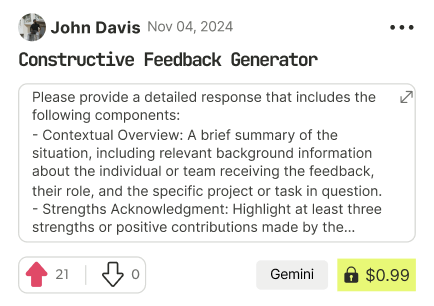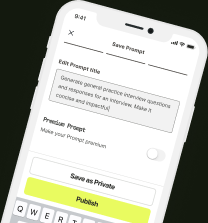prompt mine App
Find, Create & Share AI Magic
Immortal Business Model Analysis for Long-Term Wealth Creation
User Context:
- Industry Interests: Plant-based fast-food chain and industrial equipment maintenance
- Resource Capacity: Not specified, assumed moderate
- Wealth-Building Timeline: Decades-long, focused on steady wealth over short-term hype
1. IMMORTAL BUSINESS PRINCIPLES
The foundation of businesses that have created lasting wealth lies in their adherence to core principles that prioritize resilience over rapid growth. These businesses focus on delivering essential goods or services, maintaining consistent cash flows, and operating with high capital efficiency. Their enduring success is attributed to their ability to adapt to changing economic landscapes while maintaining a strong competitive advantage through natural moats, such as proprietary technology, high switching costs, or deep-rooted customer loyalty. These models often thrive during recessions because they are built around indispensable offerings that remain in demand regardless of economic fluctuations. Understanding these principles is crucial for entrepreneurs who aim to build businesses that not only survive but flourish over multiple economic cycles.
2. RESILIENT MODEL ANALYSIS
Model 1: Industrial Equipment Maintenance
- Model Name & Description: This model focuses on providing essential maintenance services to industrial clients, ensuring their machinery operates efficiently and reliably.
- Historical Success Cases: Companies like ABM Industries (founded in 1909) and Otis Elevator Company (founded in 1853) have thrived for over a century by offering indispensable services to their clients.
- Implementation Blueprint:
- Identify a niche within the industrial sector, such as heavy machinery or HVAC systems.
- Establish a service contract model that ensures recurring revenue.
- Invest in training a skilled workforce capable of handling diverse equipment.
- Defensive Characteristics: High switching costs for clients due to the specialized nature of the service; long-term contracts that provide revenue stability.
- Growth Mechanisms: Expansion into new geographic areas and additional service offerings; leveraging technology to enhance service efficiency.
- Resource Requirements: Moderate startup costs for equipment and initial workforce training; access to a network of industrial clients.
Model 2: Essential Consumer Goods
- Model Name & Description: Focuses on producing and selling essential consumer products that are always in demand, such as cleaning supplies or basic food items.
- Historical Success Cases: Procter & Gamble (founded in 1837) and Unilever (founded in 1872) have built empires on the back of essential goods.
- Implementation Blueprint:
- Develop a product line focused on essentials that are consumed regularly.
- Establish a robust distribution network to ensure widespread availability.
- Maintain high product quality to build brand loyalty.
- Defensive Characteristics: Broad market demand and brand loyalty; ability to adjust pricing during economic downturns.
- Growth Mechanisms: Product line extensions, international expansion, and innovation in sustainable practices.
- Resource Requirements: Significant initial investment in production facilities and distribution; strong marketing capabilities.
Model 3: Niche Professional Services
- Model Name & Description: Specializes in providing high-value, specialized services to a specific industry or client segment.
- Historical Success Cases: McKinsey & Company (founded in 1926) and Deloitte (founded in 1845) have sustained long-term success through their focus on professional services.
- Implementation Blueprint:
- Identify a niche where your expertise can add significant value.
- Develop a service model that emphasizes client relationships and long-term engagements.
- Invest in continuous learning to stay ahead of industry trends.
- Defensive Characteristics: High barriers to entry due to specialized knowledge; client dependency on your expertise.
- Growth Mechanisms: Expanding service offerings and entering new markets while maintaining high service quality.
- Resource Requirements: Moderate startup costs for establishing a team of experts; networking resources to connect with potential clients.
3. WEALTH CREATION TIMELINE
- 1 Year: Establish foundational operations, secure initial contracts or sales, and achieve modest revenue growth.
- 5 Years: Build a solid client base or market presence, achieve consistent profitability, and begin expansion into new areas or product lines.
- 10 Years: Establish a dominant position within your niche, achieve significant market share, and generate substantial recurring revenue.
- 25 Years: Achieve generational wealth through diversified operations, global reach, and a well-established brand with enduring customer loyalty.
4. EXECUTION ROADMAP
Step 1: Industry and Niche Selection
- Given your interest in the plant-based fast-food chain and the industrial equipment maintenance company, focus on the latter. The plant-based trend, while currently popular, lacks the historical resilience and essential nature of industrial maintenance.
- Conduct thorough market research to identify a specific niche within industrial equipment maintenance, such as specialized machinery or regional needs.
Step 2: Business Planning and Strategy
- Develop a detailed business plan focusing on service contracts to ensure recurring revenue.
- Establish a pricing model that reflects the value of your services while remaining competitive.
- Plan for initial investments in equipment and workforce training.
Step 3: Operational Setup
- Secure initial funding for startup costs, which may include leasing a facility, purchasing necessary tools, and hiring skilled technicians.
- Set up a robust operational system to manage service requests, scheduling, and client communication.
Step 4: Market Entry and Client Acquisition
- Launch your business with a targeted marketing campaign aimed at industrial clients.
- Leverage networking events and industry conferences to build relationships and secure initial contracts.
- Focus on delivering exceptional service to build a reputation and gain referrals.
Step 5: Growth and Expansion
- After achieving initial profitability (typically within 2-3 years), reinvest profits into expanding your service offerings or entering new markets.
- Continuously monitor industry trends and adapt your services to meet evolving client needs.
Step 6: Long-Term Sustainability
- Track key performance indicators such as client retention rate, service contract renewals, and profit margins.
- Implement a succession plan to ensure the business can be passed down or sold while maintaining its value.
Common Failure Points and Mitigation:
- Failure to Secure Contracts: Mitigate by focusing on building strong client relationships and offering competitive pricing.
- High Operational Costs: Maintain lean operations and invest in technology to improve efficiency.
- Lack of Differentiation: Continuously innovate and adapt to stay ahead of competitors.
Contrast with Trendy Models:
The plant-based fast-food chain, while trendy, faces significant risks during economic downturns due to its reliance on consumer discretionary spending. Historically, such models often struggle to maintain profitability and may collapse under pressure. In contrast, the industrial equipment maintenance model offers essential services that remain in demand regardless of economic conditions, providing a more reliable path to long-term wealth creation.
This roadmap provides a structured approach to building a resilient business aligned with the principles of immortal business models. By focusing on industrial equipment maintenance, you can create a business that not only withstands economic cycles but also builds generational wealth over decades.

Immortal Business Model Analysis for Long-Term Wealth Creation


Find Powerful AI Prompts
Discover, create, and customize prompts with different models, from ChatGPT to Gemini in seconds

Simple Yet Powerful
Start with an idea and use expert prompts to bring your vision to life!